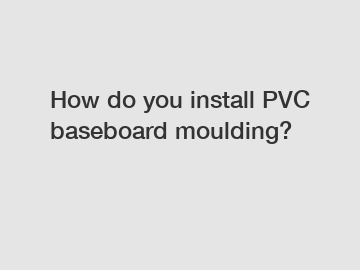How do you install PVC baseboard moulding?
How to Install PVC Baseboard Moulding: Step-by-Step Guide.
PVC baseboard moulding is not only a durable and cost-effective option, but it also adds a touch of elegance and charm to any room. Whether you are a DIY enthusiast or hiring a professional, installing PVC baseboard moulding is a relatively straightforward process. In this article, we will guide you through the step-by-step process of installing PVC baseboard moulding, ensuring a successful and visually appealing outcome.
Materials You Will Need:

1. PVC baseboard moulding.
2. Measuring tape.
3. Miter saw.
4. Adhesive or construction-grade glue.
5. Caulk gun.
6. Caulk.
7. Finishing nails.
8. Hammer.
9. Sandpaper.
10. Paint or primer (optional).
Step 1: Preparation.
Before you begin installing PVC baseboard moulding, ensure that the walls are clean, dry, and free from any dust or debris. Clear any obstacles from the area to provide a smooth working environment.
Step 2: Measure and Cut the Baseboard Moulding.
Using a measuring tape, carefully measure the length of the wall where you plan to install the baseboard moulding. Transfer these measurements to the PVC baseboard moulding and use a miter saw to make precise 45-degree cuts at the corners. Ensure that the corners match perfectly before proceeding to the next step.
Step 3: Apply Adhesive.
Using an adhesive or construction-grade glue, apply a thin layer to the back of the PVC baseboard moulding. This will help secure the moulding to the wall and prevent any gaps or unevenness.
Step 4: Install the Baseboard.
Carefully align the PVC baseboard moulding with the wall, making sure the corners sit flush. Press firmly against the wall to ensure a secure bond. For additional support, you can also use finishing nails to reinforce the baseboard moulding. Hammer the nails into place, making sure they are countersunk to allow for filling later. Continue this process until all the PVC baseboard moulding is installed.
Step 5: Fill Nail Holes and Gaps.
Using a caulking gun, fill any nail holes and gaps between the moulding and the wall with a caulk of your choice. Smooth the caulk using your finger or a putty knife for a seamless finish. Allow the caulk to dry completely before moving on to the next step.
Step 6: Sand and Paint (Optional).
If desired, you can sand the PVC baseboard moulding lightly to create a smoother surface. This step is particularly beneficial if you plan to paint the moulding. Prime the moulding if necessary and apply a coat of paint, allowing it to dry between coats. This step will add a polished and finished look to your baseboard moulding.
In conclusion, installing PVC baseboard moulding is a gratifying and relatively simple process. By following these step-by-step instructions, you can achieve a professional-looking result. However, if you are unsure about any aspect of the installation process, it is always recommended to consult with a professional to ensure a perfect installation.
For further assistance or any questions you may have regarding PVC baseboard moulding installation, please do not hesitate to contact us. Our knowledgeable team of experts is always ready to provide you with the necessary guidance.
The company is the world’s best p50 skirting detail, skirting cladding, 150mm plastic skirting board supplier. We are your one-stop shop for all needs. Our staff are highly-specialized and will help you find the product you need.


